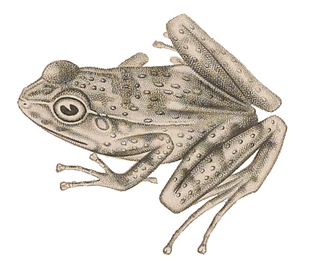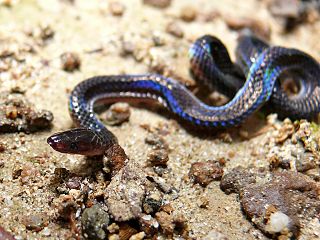Karl Patterson Schmidt was an American herpetologist.
Mertensophryne schmidti is a species of toad in the family Bufonidae. It is endemic to Democratic Republic of the Congo and only known from the Upemba National Park.
Schmidt's mountain brook frog is a species of frog in the family Hylidae. It is endemic to the Pacific slopes of the Sierra Madre de Chiapas in southwestern Guatemala and southern Mexico in eastern Oaxaca and southwestern Chiapas. It is named after Karl Patterson Schmidt, American herpetologist, and his brother Frank, who collected with him.

Crossodactylus is a genus of frogs in the family Hylodidae. The genus occurs in Brazil, southern Paraguay, and northern Argentina. These frogs are sometimes known as Limnocharis, Tarsopterus, Calamobates, and by the common name spinythumb frogs. They typically inhabit streams in mountainous areas in the Atlantic Forest or in montane savanna.

Crossodactylus dantei or the Murici spinythumb frog, is a species of frog in the family Hylodidae. It is endemic to Brazil. Scientists know it exclusively from the type locality: Murici, in Alagoas. Its natural habitats are subtropical or tropical moist lowland forest and rivers. It is threatened by habitat loss.
Crossodactylus dispar is a species of frog in the family Hylodidae. It is endemic to Brazil. Its natural habitats are subtropical or tropical moist lowland forest, subtropical or tropical moist montane forest, and rivers. It is threatened by habitat loss.

Crossodactylus gaudichaudii is a species of frog in the family Hylodidae. The species is endemic to Brazil.
Crossodactylus grandis, or the Bahia spinythumb frog, is a species of frog in the family Hylodidae. It is endemic to Brazil. Its natural habitats are subtropical or tropical high-altitude grassland and rivers. It is known solely from the Parque Nacional do Itatiaia in Minas Gerais in Brazil, where it lives in cloud forests. It is threatened by habitat loss.
Crossodactylus lutzorum is a species of frog in the family Hylodidae. It is endemic to Brazil. Scientists know it exclusively from the type locality: Fazenda Água Branca in Bahia. Its natural habitats are subtropical or tropical moist lowland forest and rivers. It is threatened by habitat loss.
Crossodactylus trachystomus is a species of frog in the family Hylodidae. It is endemic to the Espinhaço Mountains in Minas Gerais, Brazil.
Strabomantis ingeri, or Inger's robber frog, is a species of frog in the family Strabomantidae. It is found on the eastern and western slopes of the Cordillera Oriental, Colombia. Its altitudinal range is 1,550–3,320 m (5,090–10,890 ft) asl. It might also occur in adjacent Venezuela. It is named after Robert F. Inger, an American zoologist from the Field Museum of Natural History.
Eleutherodactylus schmidti is a species of frog in the family Eleutherodactylidae endemic to Hispaniola, and found in both the Dominican Republic and Haiti. It is sometimes referred to as the Schmidt's robber frog. It is named in honour of Karl Patterson Schmidt.
Hydrolaetare schmidti is a species of frog in the family Leptodactylidae. It has a scattered distribution in the Amazon Basin in Brazil, Colombia, French Guiana, and Peru. Its natural habitats are subtropical or tropical moist lowland forest, subtropical or tropical swamps, rivers, and freshwater marshes. It is named after Karl Patterson Schmidt, American herpetologist.
Oreolalax schmidti is a species of amphibian in the family Megophryidae. It is endemic to China where it can be found in the Hengduan Mountains in western Sichuan and northern Yunnan provinces. Its natural habitats are temperate forests, subtropical moist shrubland, rivers, swamps, and freshwater marshes. It is threatened by habitat loss. It is named after Karl Patterson Schmidt, American herpetologist.
Thorius schmidti, commonly known as Schmidt's pigmy salamander, is a species of salamander in the family Plethodontidae. It is endemic to Mexico and only known from near the village of Zoquitlán in the Sierra Madre de Oaxaca of southern Puebla, possibly also from Oaxaca. It is named after Karl Patterson Schmidt, American herpetologist.
Cornufer schmidti is a species of frog in the family Ceratobatrachidae. It was first described as a subspecies of Platymantis papuensis. It is the type species of the subgenus Aenigmanura within Cornufer. It is endemic to the Bismarck Archipelago, Papua New Guinea, and is known from the islands of New Britain, New Ireland, and Manus; the Manus population might represent a distinct species.

Amphisbaena schmidti, known commonly as Schmidt's worm lizard or the Puerto Rican dusky worm lizard, is a species of amphisbaenian in the family Amphisbaenidae. The species is endemic to the Caribbean.

Calamaria schmidti, known commonly as Schmidt's reed snake, is a species of snake in the family Colubridae. The species is endemic to Malaysia.

Acanthodactylus schmidti, also known commonly as Schmidt's fringe-fingered lizard or Schmidt's fringe-toed lizard, is a species of lizard in the family Lacertidae. The species is endemic to Western Asia.
Crossodactylus cyclospinus is a species of frog in the family Hylodidae. It is endemic to Brazil and has been observed in two localities in Minas Gerais, both on the Jequitinhonha River.






